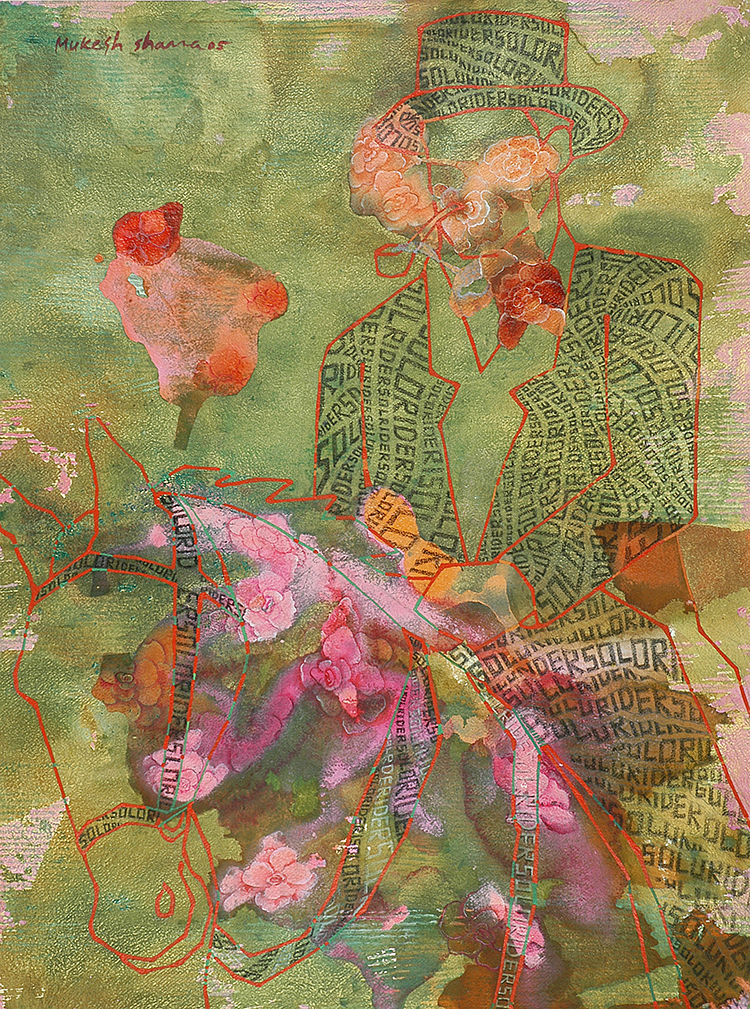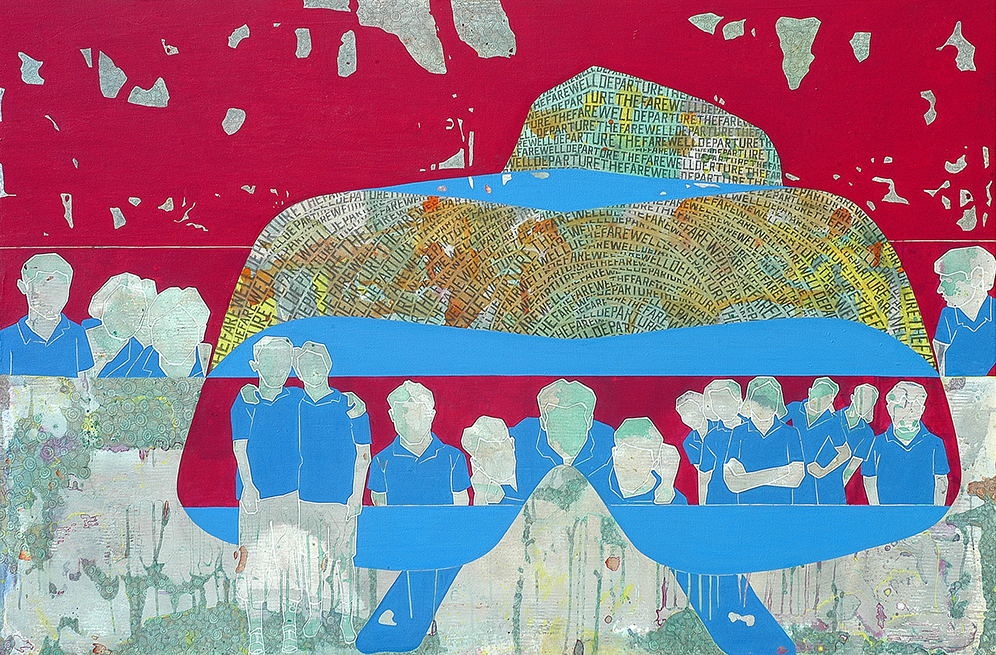By Deborah Williams,
USA
April 2006
Solo Exhibition Drawings and Paintings: World Without Boundaries at Qualcomm, Mumbai and at Galleria Corona, PTO, Vallarta, Mexico
Technical excellence, of course, is what we expect from a Master of Fine Arts graduate of Baroda; but Jaipur-based painter and printmaker Mukesh Sharma’s artistic maturity, originality and commitment to his unique vision are simply astonishing in such a young artist. His work as a whole brings to mind the virtuosity and sureness of touch of a master musician, for Mukesh has the ability to express a range of emotions – brooding, joyful, serene – combined with a perfect sense of pitch and a perfect eye for color. He is in command of whatever medium he uses, and combines multiple media beautifully in works of great richness, depth and texture.
Mukesh’s work up to 2004 combines a rootedness in the traditions, motifs, colors, and landscape of his native Rajasthan, with a distinctly post-modern vision and a willingness to experiment with the most contemporary materials and practices. Traditional Rajasthani textile patterns and architectural motifs abound in these works, yet they are totally unique interpretations. It is this combination that gives his work great vitality – a playful reworking and reclaiming of our cultural heritage that makes it fully present. The prints and paintings in his 2004 Australian exhibit – appropriately titled “(Re)Visions” –excel at taking images which are mundane (a fence, a wall, a couple), or perhaps even trite (the Taj Mahal), and transforming them so we see them anew.
Following his highly successful exhibits in Australia, Mukesh’s work changed. The newer material featured in this exhibit is more worldly in its subject matter and, subtly, more political; yet the same interest in both cultural images and how we see the world remains. Flags of different nations appear often, always reinterpreted or reinscribed (with patterns from Aboriginal art, for example), drawing our attention, in some pieces, to the mediated, contested nature of cultural iconography, and in others, to it’s commodification and commercialization. These pieces are especially poignant in this day of nationalistic chest-thumping, when conservatives in many countries would like us to believe there is only one meaning to patriotism and only one way to enact it.
Other new work features the recurring trope of a pair of sunglasses — in which we see not the wearer’s eyes but the reflection of the people he or she is gazing at – drawing our attention to the subjective nature of vision itself. The world is not simply there to be captured by our objective, disinterested gaze. We actively construct reality through looking (and through painting). Indeed, in these heavily layered, dreamlike images, many of Mukesh’s faces have no eyes at all, insisting that what matters is not what we see but what we make of it.
_______________________________________________________________________________________
By Heather Beal,
Writer, poet and critic
USA
April 2006
While the openness, optimism, and engaging imagery that have distinguished Mukesh Sharma’s art throughout his career remain, his vision now extends far beyond the familiar landscapes, street scenes, and architectural motifs of his native Rajasthan. His themes are more global. The boundaries are blurring; the layers deepening.
For example, in “Executive Class” and “Raffles Class” outlines of planes, cars, and railways are juxtaposed with intimate scenes of people laughing or walking arm in arm. These are laid over rich and textured topographies that create maps with natural rather than political borders. We pause to wonder: is a world more tightly connected by advanced transportation technology also closer in human terms?
Other works also elicit rumination and reflection as pop figures, such as cowboys, movie stars, musicians, and athletes, or symbols of achievement, such as sunglasses, filmstrips, and flowers float on the surface of brilliant, bold collages of color. While snapshot seconds of success pass quickly, life in all its rich range of emotions moves infinitely onward.
Thus the meditative qualities long associated with Sharma’s work are still present and, perhaps, have intensified.
It is as though Sharma first empties himself, clears away the clutter of predispositions, and sees the world with fresh eyes – as a tabula rasa—before allowing its hues to return, seep into, and revitalize all aspects of existence. He sketches a freeze-frame to capture a fleeting image, suspend a scene, and convey experience in its most essential forms.
While the figures in the foreground seem to stand still, kaleidoscopic backgrounds keep moving. Energy flows up from the earth and streaks across the horizon. It effervesces and floats beyond the edges of “Dido’s Life for Rent.” It runs in rivers into lakes and oceans in “Frenzy M” and “Yolngu Boy.” It streams as words through strands of hair, down and across clothing, around hats and heads, and over horses and harnesses in “Dreams on Celluloid,” “Nation’s Pride,” “Solo Rider,” “Speed Line,” and other works. It cascades through the “Hot Spot” series. This is life liberated: sometimes ordinary, with small gestures and everyday objects transformed by color, context, and composition; sometimes adorned, wreathed in pomp, pageantry, and glory.









